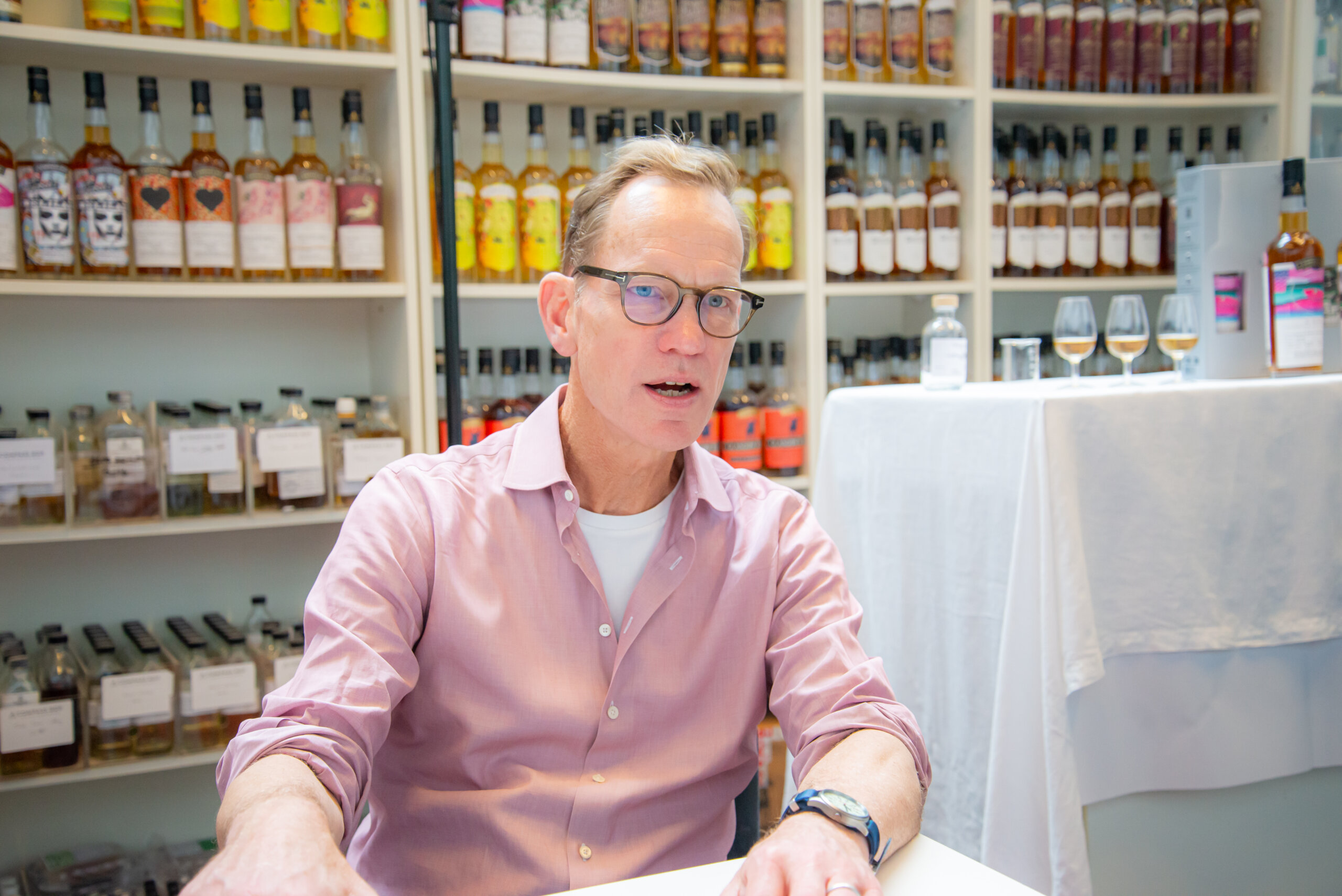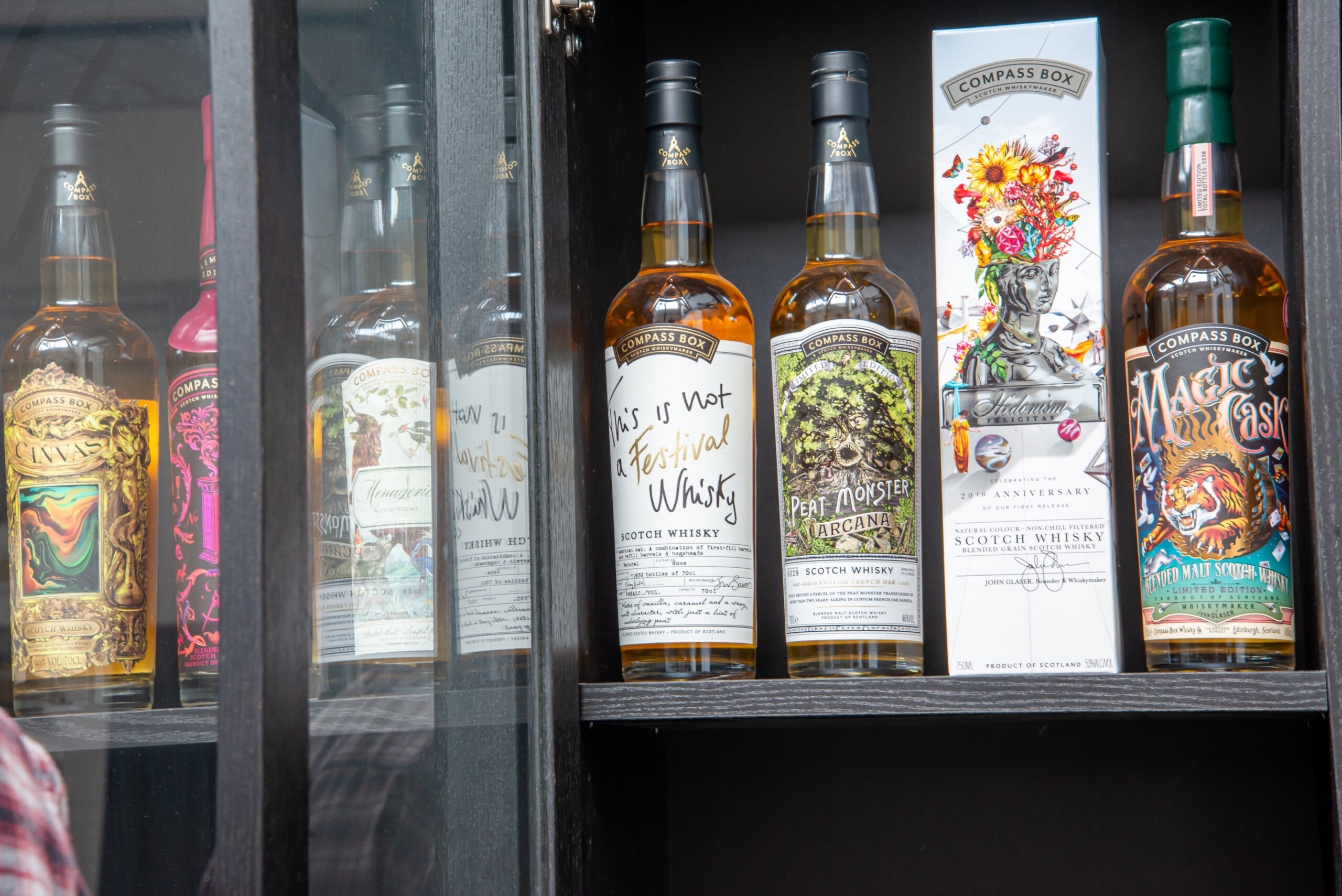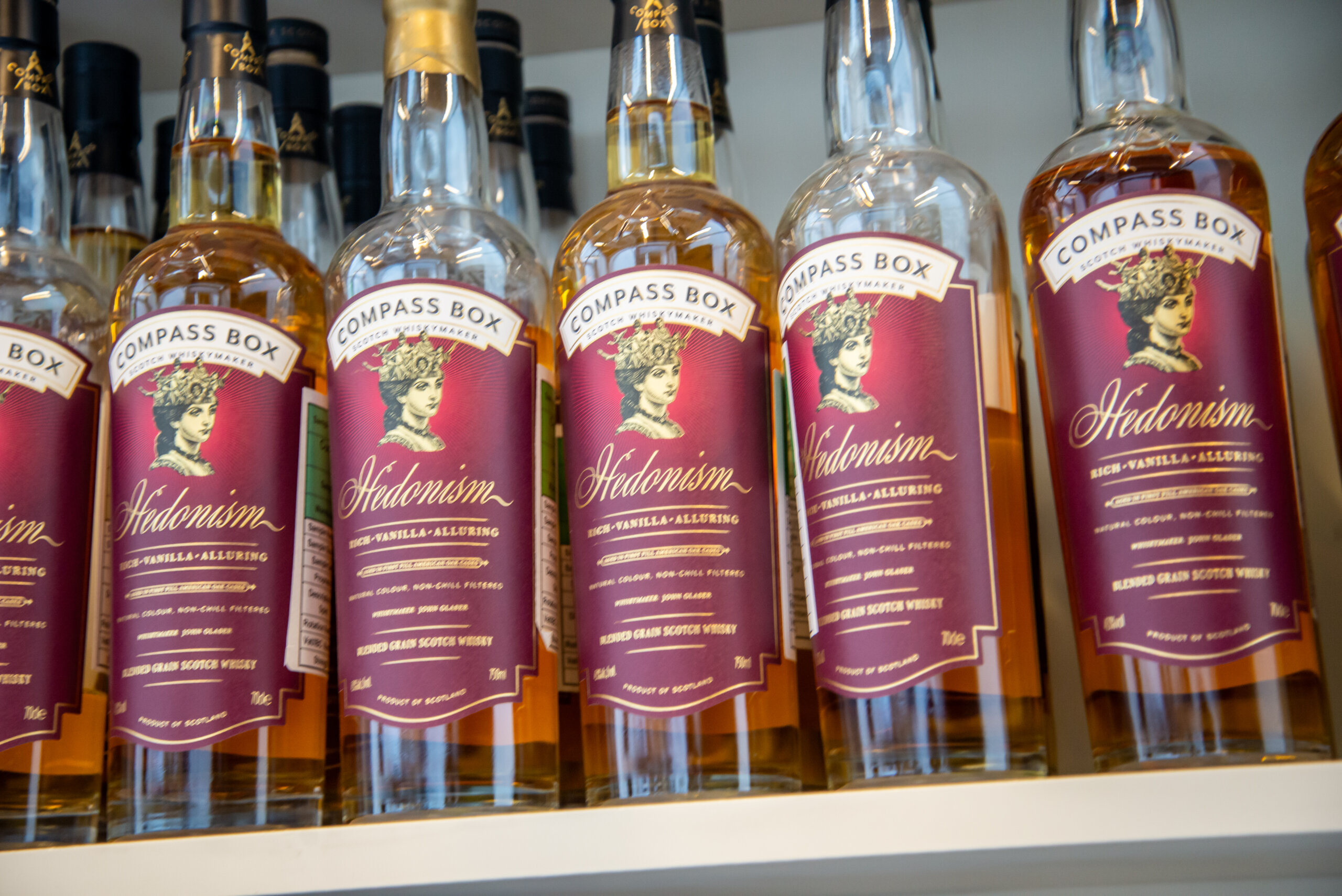
【現地レポート】創設者キャンベル夫妻と8ドアーズ蒸溜所に迫る!!
- 造り手
- 蒸溜所(海外)
 アイキャッチ231009-12.png)
Compass Box is not a distiller and is more than a blender. It is a “Whiskymaker,” explained on their website. Located in London, it is known for its revolutionary approach to blending and bottling. With its spirit of always seeking new possibilities to improve, it has added joy to the Scotch whisky industry and attracted worldwide whisky lovers.
This time, Dear WHISKY conducted an exclusive interview with John Glaser, who is a founder and blender of Compass Box. This article reveals the secrets behind its unique whisky-making and the founder himself.

| Company’s Name | Compass Box |
| Year of Establishment | 2000 |
| CEO | Maurice Doyle |
| Location | Compass Box Whisky Chiswick Studios 9 Power Road London W4 5PY UK |
| Official Website | Compass Box |
Dear WHISKY:
How did you find your interest in the alcoholic beverage industry?
John:
I had the ambition to become a winemaker, so my interest in the alcoholic beverage industry started from wine. I studied winemaking in California and worked in various jobs in the wine industry. However, when I was working in a big wine store in Connecticut, the person there told me that I should be on the business side of wine rather than making it. They convinced me to go back to school and study business, so I went to school again and got a business degree.
Dear WHISKY:
What changed your career from the wine to the whisky business?
John:
After I finished school, I could hardly find a job in the wine industry. However, I was able to receive an offer from Johnnie Walker, a major blended whisky company that also had wine brands. Although the offer was a marketing job, I took it, because I thought I could move into the wine business after a short period involved in the whisky industry. However, they took me to Scotland and when I came here, I fell in love with Scotch whisky.
Dear WHISKY:
When did you start blending by yourself?
John:
In my Johnnie Walker days, I started blending by myself at home. Back then, I was still living in New York, but I was already captivated by blending as a creative act. I had my first own blending room when I started Compass Box. However, that blending room was in the kitchen at my house.

bottles in the blending room
Dear WHISKY:
How did you get the skill and knowledge of whisky blending?
John:
Since I came from the wine business, I think I had a sort of organoleptic assessment experience. When I was doing the retail job in the wine industry, much of my work was assessing wines every day. So that came very easily when I started trying to understand the smell and taste of whisky.
Dear WHISKY:
Do you think that the blending of whisky is also applicable to making wine?
John:
Absolutely. Blending to me simply is representative of creativity. In general, a creative idea is just combining ideas that are already out there, in a way that no one’s done before. For example, if you have three whisky here, I could make a thousand different whisky by blending them in different ways. I think such creativity is definitely applicable to winemaking.
Dear WHISKY:
What made you start Compass Box?
John:
When I started Compass Box 24 years ago, Scotch whisky as an industry was in a hard time. Global sales were flat or declining both in the European and North American markets. Therefore, I wanted to do something different with Scotch whisky to make it more relevant and approachable to customers. However, that idea was not considered a big enough opportunity in the company where I worked. Therefore, I decided to resign the post and start a new company.
Dear WHISKY:
What do you mean by you wanted to make whisky more relevant and approachable?
John:
Back in the late 90s, there were rules around Scotch whisky like you can only drink it in certain ways. However, I think that there is no rule, only a perception of rules. So, I found it important to show people that the Scotch whisky could be drunk in any way you like.

Mr. John Glaser
Dear WHISKY:
How has being American influenced your career within the Scotch whisky industry?
John:
America is where there are a lot of entrepreneurial businesses, so doing things in their way and challenging the status quo is often the thing. When I came to the UK and was focused on the Scotch whisky industry, one question I had was how come no one is making a change. Being a foreigner, I was able to have prospects in the Scotch whisky industry with different perspectives. I didn’t see the rules, I just saw the opportunity. Therefore, I think there was an advantage to being a foreigner, being an American.
Dear WHISKY:
What is your current role in Compass Box?
John:
I oversee all the aspects of whisky-making today. James Saxon, who is our whisky maker and responsible for product development, manages it on a day-to-day basis, but at the end of the day, I’m responsible for making the major decisions on our future. I was the chief executive until new investors brought a new one a year and a half ago. Now I’ve been able to step back and focus more on whisky and what we’re doing in the future.
Dear WHISKY:
What is your typical day of working at the Compass Box?
John:
There is no typical day to begin with. It’s partly because we’re a small company and we do many things with not many people, but also because it’s an entrepreneurial company in which people are doing many different things. After 24 years since the establishment, I still feel like we are a startup company.
Dear WHISKY:
What is the story behind the name?
John:
When I was selecting the name for the company, my criteria was to make it sound non-Scottish and stand out from other names. Constellation was what I found so fascinating, so many of the names on the list were based on them. Compass Box was also the English name of a constellation, Pyxis in Greek. That’s where the Compass Box came from.
Dear WHISKY:
What distinguishes your products from others?
John:
I think the design is one thing that sets Compass Box apart from other whisky brands. It’s not just about the liquid in the bottle, but it’s also about the idea behind the liquid.
For example, one of our products, Extinct Blends Quartet, has the idea to reimagine some of the famous blends from many decades ago, and the design reflects such a concept.

the Extinct Blends Quartet
Dear WHISKY:
Who designs the labels of your products?
John:
We work with our graphic designers, Stranger and Stranger whom we’ve been working for over 15 years. They bring the concept to life graphically.
Dear WHISKY:
What is the process of building a product?
John:
We start with deciding the concept. The next steps are to get a liquid and give it a name. It is the concept that is the base of the products. These aspects are all connected to create our little poetic biosphere.
Dear WHISKY:
What is the concept behind your famous “No Name series”?
John:
Its concept is that we do not give whisky the name to let the whisky speak for itself. We have “No Name,” “No Name No.2,” and “No Name No.3,” and each represents our re-imagining of a different Islay single malt whisky.
Dear WHISKY:
What are the characteristics of each bottle? Is “No Name No.4” going to come out?
John:
The first one, “No Name”, was based on malt whisky from the Ardbeg distillery. We don’t bottle just a single malt, but we add a few other whisky to add some aspects. The second one was based on Caol Ila malt whisky from the Caol Ila distillery. Again, Caol Ila with just adding a little touch of other whiskies to dress it up in our way. Finally, the third one was based on malt from the Laphroaig distillery. However, that’s where we plan to stop because we don’t have enough amount of other whisky from other Islay distilleries to do another in the series.
Dear WHISKY:
How are your target customers different from other brands?
John:
A lot of Scotch whisky brands target people who want to make them feel successful or make them fit in by drinking whisky. They tend to be male drinkers on the elderly side. In contrast, people who choose Compass Box want to stand out from others.Currently, we are targeting customers on the younger side. Since they tend to be open-minded about the choices they make and seek out discoveries, they fit our innovative branding strategy.
Dear WHISKY:
Do you think the standpoint of the blended whisky in the industry changed over the past couple of years?
John:
Yes, for sure. When I started Compass Box, there was virtually no interest in blended Scotch whisky among Scotch whisky enthusiasts. Their focus was always on single malt brands. However, today even some big companies are introducing new blended Scotch whisky brands. So, I think we’ve contributed in some way to opening up the minds of people to see blending as a creative act.
Dear WHISKY:
How do you think the perception of whisky has changed among consumers?
John:
More people understand that it’s not necessarily the category that is important when you’re choosing a Scotch whisky. It is now more about the makers rather than the category. So, I think such a change in the whisky market will continue and become more positive in the future.

a selection of bottles produced by Compass Box
Dear WHISKY:
How do you start your blending process?
John:
We usually start with the idea and try maybe 20 or 30 different recipe variations in the order of the list that we have. However, we don’t hesitate to go back and take it again. There’s a fantastic Quote of Pablo Picasso on that wall over there. “I begin with an idea, then it becomes something else.” As the quote suggests, we start with an idea but it can become something else at the end.

“I begin with an idea, then it becomes something else” – Pablo Picasso
Dear WHISKY:
How do you come up with new whisky flavours?
John:
In general, there’s no single way of doing it. Inspirations come from different places, but the basic process involves the idea that we want to make an ideal flavour style. We’ll try some ingredients that could help us achieve it, and then we’ll pull them together and start an iterative process. We will iterate sometimes as many as 30 or 40 times over months to get as close to that ideal style as possible.
Dear WHISKY:
How do you normally select casks?
John:
There’s always a reason behind the selection, but it’ll be different depending on the idea. We use a lot of what we call a prototype of an idea. James adds three to four whiskies and makes them. We’ll taste it together and talk about it and then we’ll decide which combination of casks to use. It’s a discussion and a collaboration.
Dear WHISKY:
Do you have specific rules for the percentage of key malt?
John:
We do have a recipe with a specific percentage. However, the rules are not our priority. We rather follow our intuition.
Dear WHISKY:
Has the recipe changed over the years?
John:
Many companies in Scotland talk about how the product has not changed in hundreds of years. However, we rather reserve the right to change and improve them. We don’t fundamentally change but evolve them several times over the years. For example, we released a new version of our best-selling whisky, “Peat Monster,” in 2019.

Bottles with unique designs, including Peat Monster Arcana
Dear WHISKY:
Do you have the house-style whisky?
John:
It was definitely yes in the early years, and I think we still do so today to a certain extent. In the early years, I was trying hard to adhere to the house style, which has softness and sweetness derived from the American oak casks. Although we have expanded our house style to other types of casks that give other flavours, the softness and sweetness of American oak casks are always part of our house style. The vanilla character and the sweetness you get from American Oak are still present in many of our whisky today.
Dear WHISKY:
How do you keep the unique flavour in the blending process?
John:
We don’t do the chill-filtering process. It separates oils and fats in the whisky that cause cloudiness by chilling it close to the freezing point of water and passing it through a filter. With this process, the whisky will always be clear but lose flavour and mouthfeel, particularly, softness and sweetness. Although most Scotch whisky producers use this process, we avoid it to keep the ideal flavours.
Dear WHISKY:
Do you also have smoky whisky on your selection of pallets?
John:
Of course. We have very smoky and medium smokey whisky. Also, there are even products like 8% of the recipe is malt whisky from the Bowmore distillery.
Dear WHISKY:
What do you value the most when you expand the flavour range?
John:
All of our whisky is tied together by a balance. Balance is fundamentally important to any drink. However, it is fundamentally important in Scotch whisky, because it is what separates great whisky from average whisky.
Dear WHISKY:
What are the characteristics of the great whisky?
John:
Great whisky is so compelling that it draws you back to the glass for the next sip, and makes you want to order the next glass. So, what we are looking for is a compelling nature in whisky, not just a good quality, because a technically good quality could be boring.
Dear WHISKY:
How do you recommend people to drink your product?
John:
People can drink in any way they want. However, one interesting way to drink Hedonism is by putting it in the freezer. Hedonism is a-hundred-percent scotch grain whisky aged in American oak casks, so the vanilla character from the cask seems to be concentrated when you freeze it. Drinking semi-frozen Hedonism is very fun because it is like eating vanilla ice cream.

Hedonism
Dear WHISKY:
Do you use Japanese whisky for your blend or have you ever used Japanese whisky?
John:
We’ve never used Japanese whisky because they’re very hard to get here in the UK. However, I did have an opportunity to use Japanese whisky about 15 years ago. I was being offered old whisky from the Karuizawa distillery in the 1970s. I put together a blend of 30-year-old Japanese whisky and we created a label with Koto, a Japanese instrument. However, when we were finally ready to buy that whisky, the broker said he could not sell it as the people who owned it wanted to do something different with it. So that’s as close as I got to using Japanese whisky.
Dear WHISKY:
How do you feel about Japanese whisky?
John:
I haven’t been to Japan since before I started Compass Box, but I have been keenly interested in Japanese whisky for as long as I’ve been in Scotch whisky. I respect it and admire it. And I have to say that we at Compass Box and I think other companies in Scotland have been inspired by Japanese whisky and Japanese whisky makers in terms of quality orientation and their belief that you can always improve what you’re doing.
Dear WHISKY:
How do you want to expand Compass Box in the future?
John:
Our business is 24 years old now, but it’s on a constant evolution. We do continue to grow and try to reach more whisky drinkers in more parts of the world. We are going to have a new office because we need more space for the increasing number of people we have. So there’s a lot of growth that we anticipate for the future for sure.
Dear WHISKY:
What is the plan of the company?
John:
Even if we achieve our growth and aims, our objectives over the years will always be small. We will always be niche. I think Compass Box is a brand that is known for pushing boundaries, trying new things, and having the courage to challenge the status quo. That philosophy won’t change. So, I expect us to continue to evolve.
Dear WHISKY:
How about yourself? Do you have anything you want to try in the future?
John:
I have been here in the UK for 25 years, and I have both UK and US citizenship, but the UK is definitely home to me. Maybe one day we will branch out and make Compass Box Wine. Who knows what will happen?
https://youtube.com/shorts/PnLAgXNAY58?si=zHGZl9312Q-C1V8y
This is the end of our interview with John Glaser. Thank you for reading til the end!
Compass Box always have initiatives to challenge the status quo and create a revolutionary product. With a unique career and a passion for whisky-making, John has been creating products of Compass Box based on well-thought-out concepts with attractive flavours. We hope that this will become the opportunity to try and discover the art of flavour from Compass Box.
Please keep an eye on the future adventure of Compass Box!